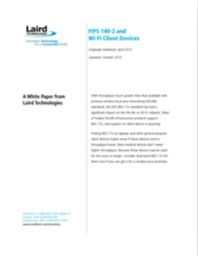FIPS 140-2 and Wi-Fi Client Devices
With throughput much greater than that available with previous wireless local area networking (WLAN) standards, the IEEE 802.11n standard has had a significant impact on the WLAN, or Wi-Fi, industry. Most of today's WLAN infrastructure products support 802.11n, and support on client devices is growing.
Putting 802.11n on laptops and other general-purpose client devices makes sense if those devices need a throughput boost.Most medical devices don't need higher throughput. Because those devices may be used for five years or longer, consider dual-band 802.11n for them now if you can get it for a modest price premium.
Download this whitepaper to learn more.
Read More
By submitting this form you agree to Laird Technologies contacting you with marketing-related emails or by telephone. You may unsubscribe at any time. Laird Technologies web sites and communications are subject to their Privacy Notice.
By requesting this resource you agree to our terms of use. All data is protected by our Privacy Notice. If you have any further questions please email dataprotection@techpublishhub.com
Related Categories: Communication, Components, Embedded, Power


More resources from Laird Technologies

Moving Beyond Zigbee® for Star Networks
Multi-hop mesh protocols, such as Zigbee® , are getting a lot of press for their ability to link together low data-rate Machine-to-Machine (M2M) a...

Wi-Fi© Client Device Security & HIPAA Compliance
According to ABI Research, the use of wireless local area networking (WLAN) technology in healthcare grew 60% globally in 2009.
Connecting me...

Wi-Fi: The Importance of Mobility in Industrial Environments
One reason Wi-Fi technology is so popular is because WiFi products from different vendors interoperate, or work together. The Wi-Fi Alliance® , a ...
